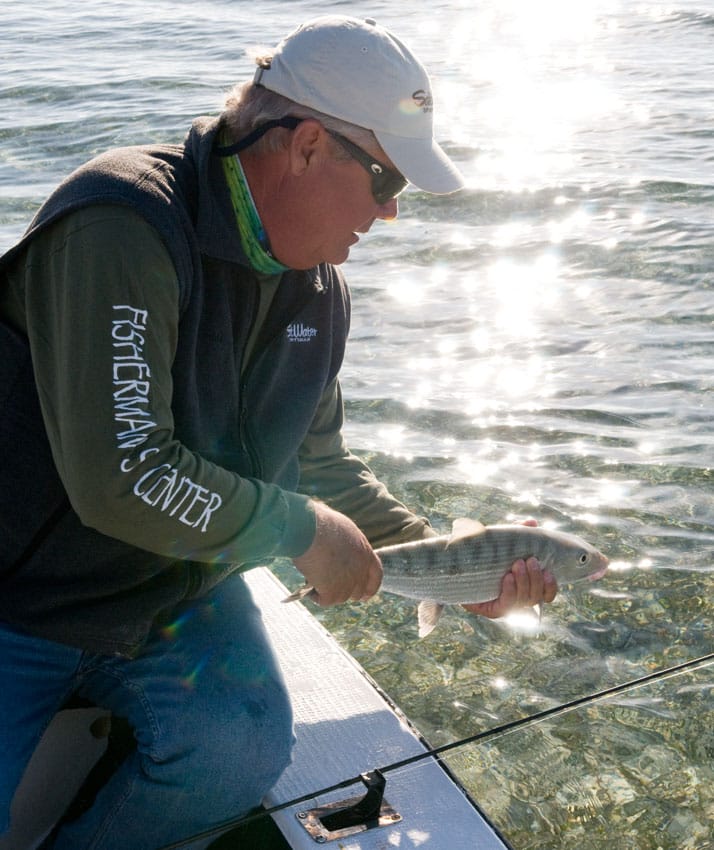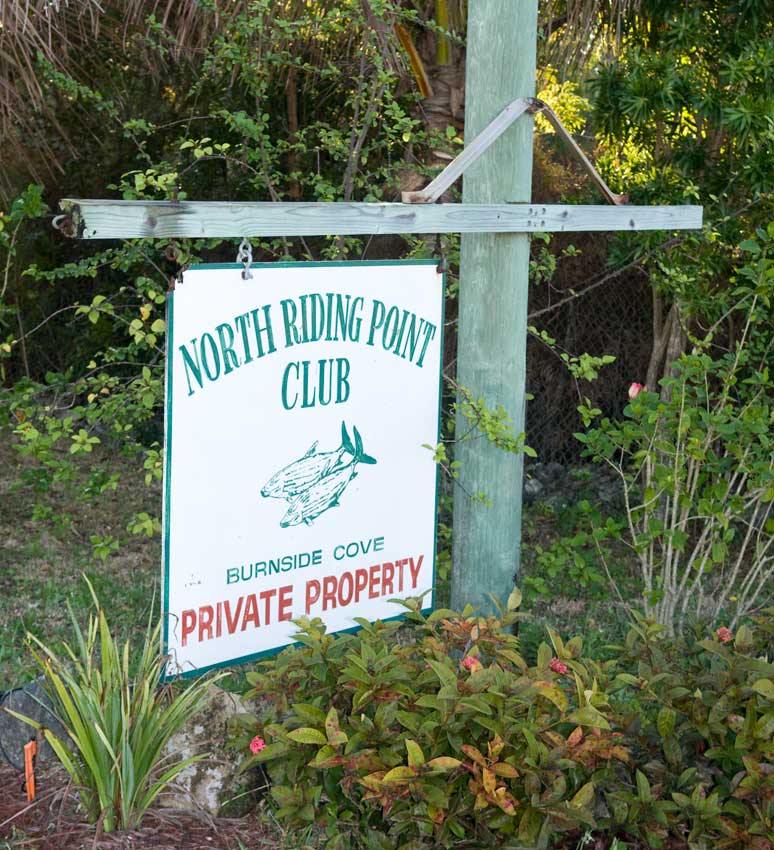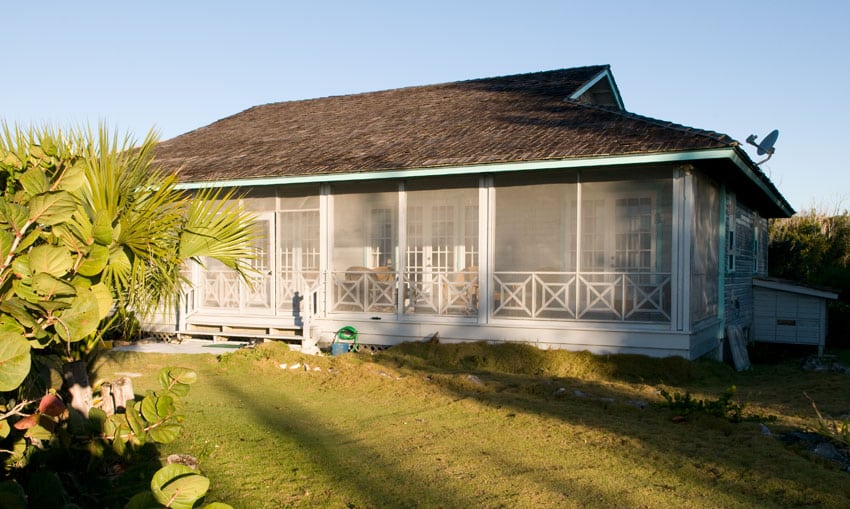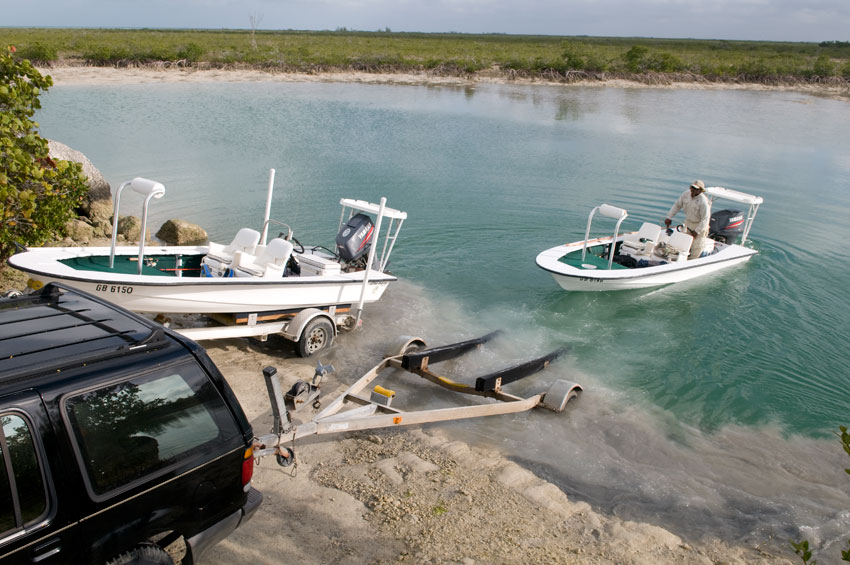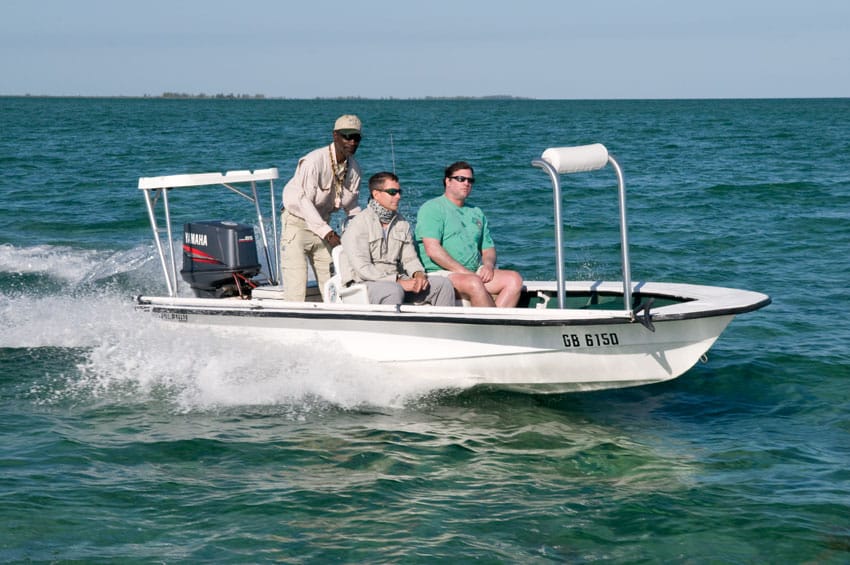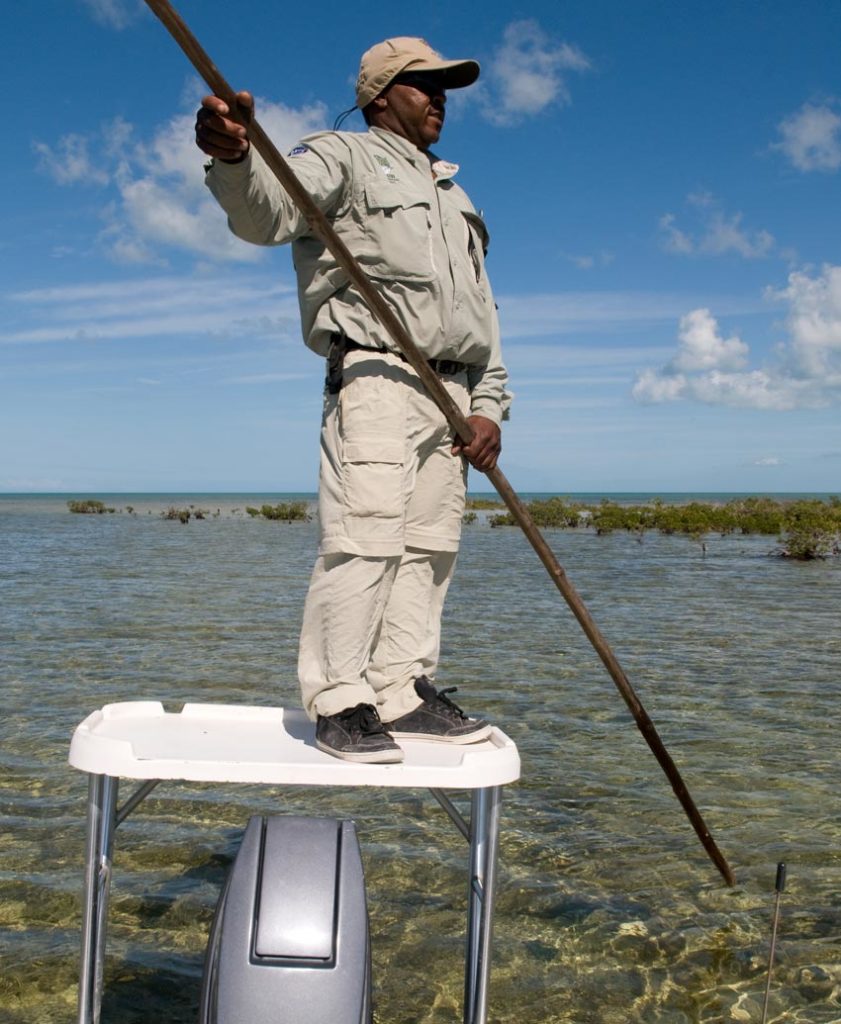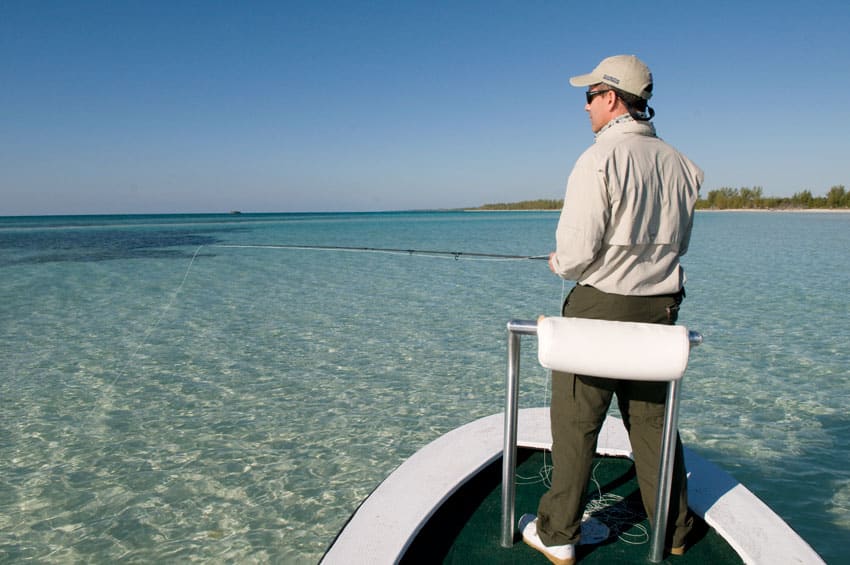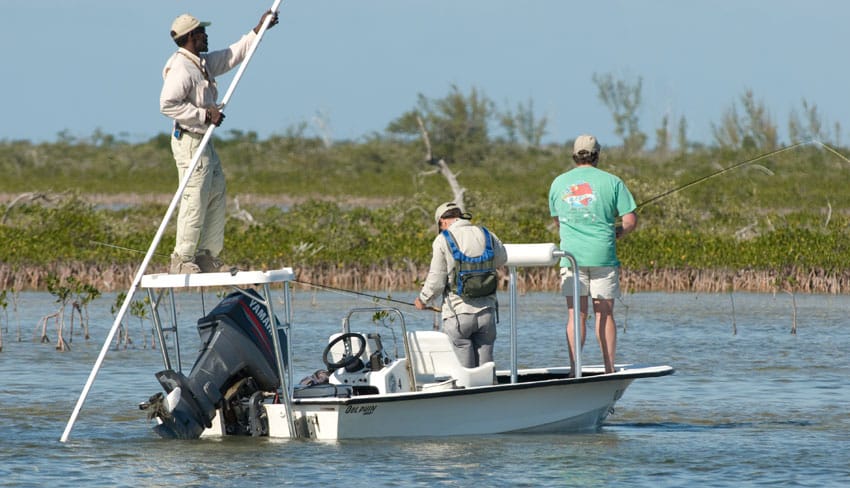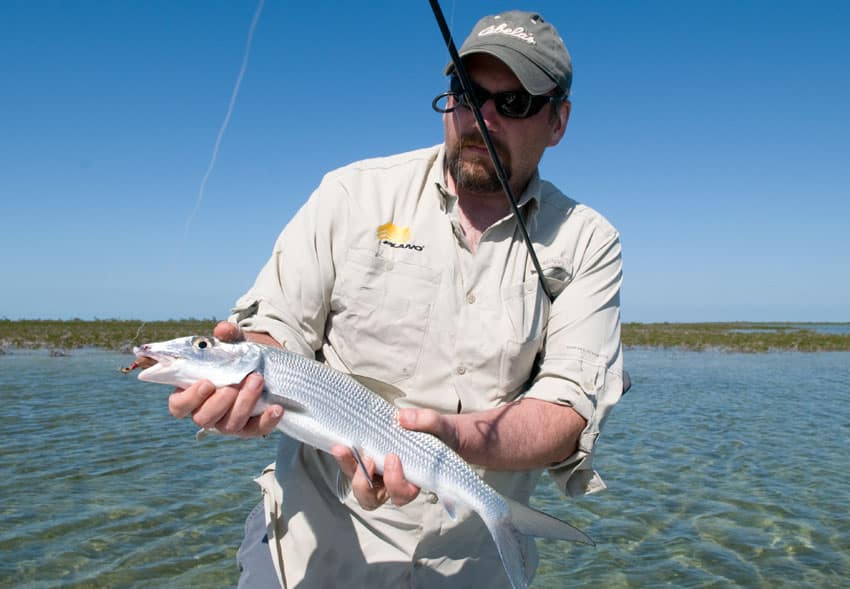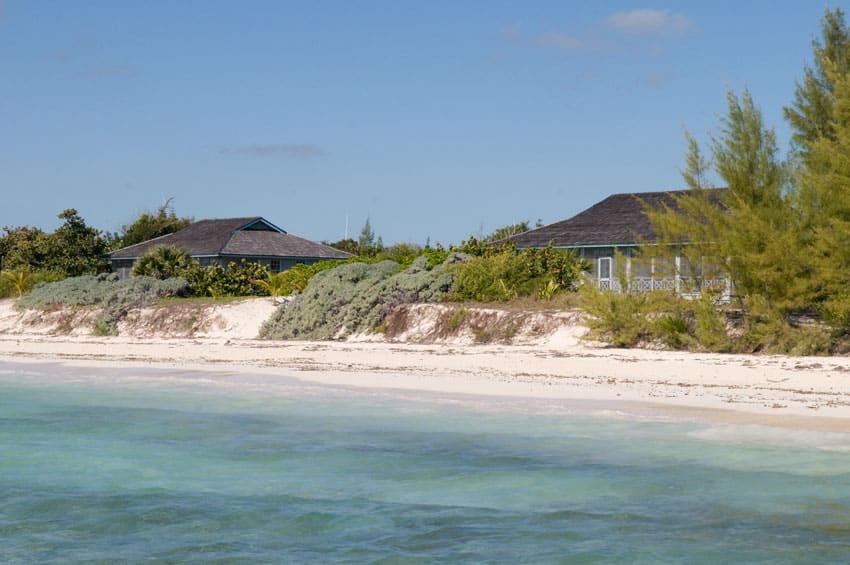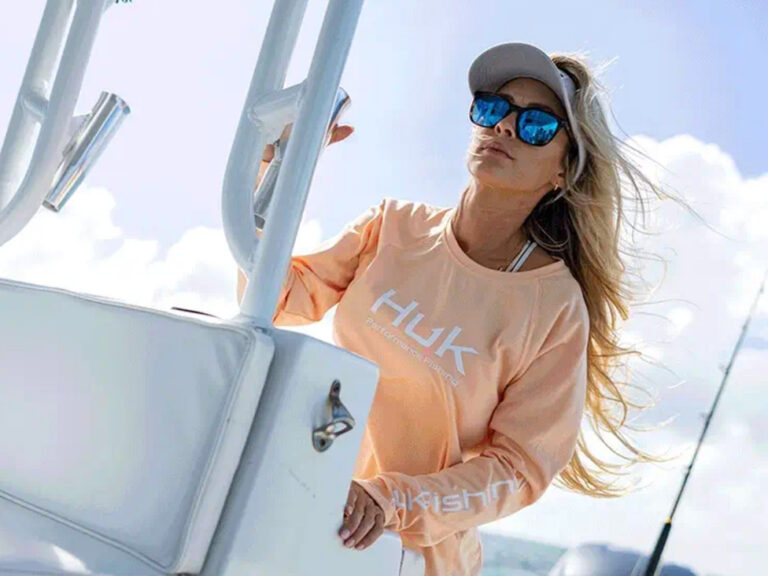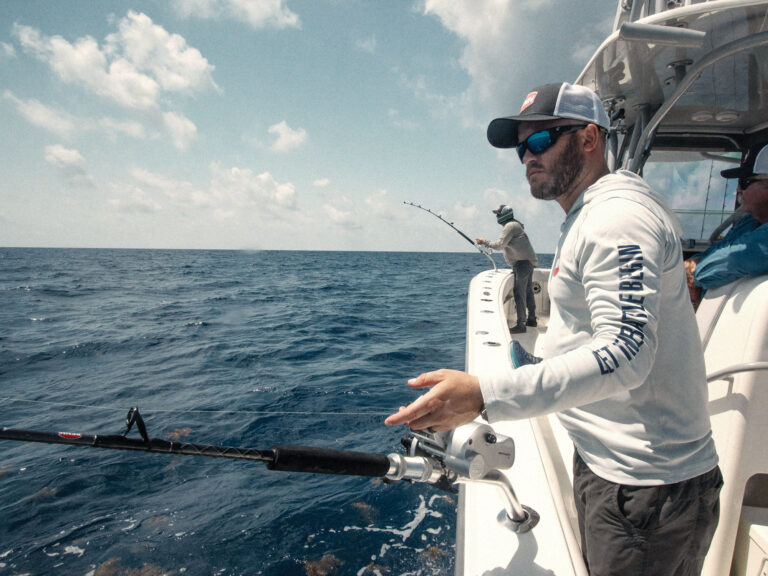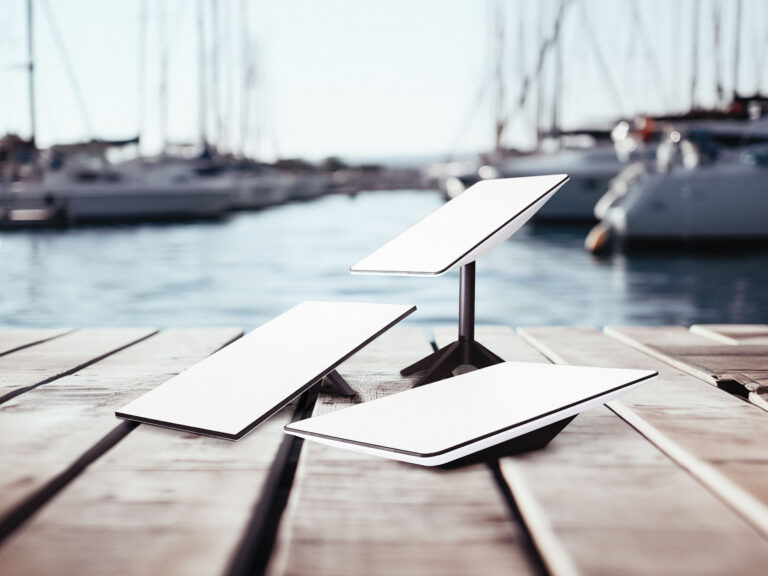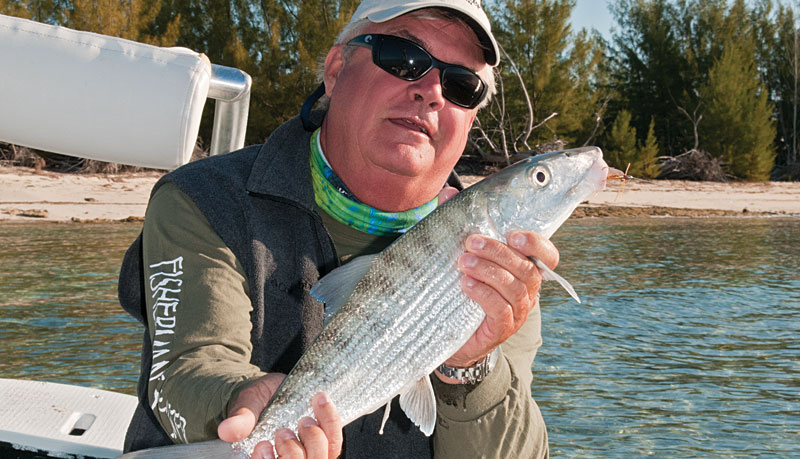
Guide Stephen Tate leaned hard against his push pole, which until recently had been the trunk of an immature Australian pine tree, moving his flats skiff closer to the mangroves and into the path of an approaching pair of bonefish.
Gerry Bethge stood on the bow, armed with a spinning rod with a brown bonefish jig tied to its leader, watching the fish as they swam closer. “Get ready,” Tate said. “OK, cast now — lead them a little bit!” Bethge tossed the jig into the path of the fish, no small feat since we faced a stiff afternoon breeze, and on Tate’s instruction, he began working the jig in a hopping motion with the rod tip.
Both fish saw the jig and made a beeline for it. The one that arrived first didn’t hesitate, pouncing on the perceived meal, and when Bethge felt the bite, he raised the rod tip, and line screamed from the spinning reel; he had hooked our first bonefish of the day. After a brief fight and few quick photos, Tate released the 5-pound fish and we resumed poling along a long section of mangrove shoreline.
Extensive Habitat
Bethge and I had flown to Freeport, on Grand Bahama Island, Bahamas, with Jesse Simpkins of Plano Molding and Jeff Weakley of Florida Sportsman magazine to check out the bonefish action provided by the North Riding Point Club, a premier bonefish resort located east of Freeport. The club’s name is ironic, since it’s situated near South Riding Point, on the island’s southern shore, but most of the fishing takes place along the northern shoreline of Grand Bahama, near North Riding Point, hence the name.
Mobile Fleet
The NRPC maintains a fleet of Dolphin flats skiffs manned by a group of excellent Bahamian captains, who trailer the boats to ramps located around the island each morning. This gives you maximum flexibility and also ensures that there won’t be too many boats working a single area on a given day, because the fleet can spread out.
That’s usually not a problem anyway, because Grand Bahama has vast areas of bonefish habitat along its northern shoreline. You can fish around hundreds of mangrove islands, in dozens of saltwater creeks flowing out of the island’s interior and around the many points that jut north into the Little Bahama Bank.
The main area the guides fish lies east of Halls Point, essentially the eastern half of Grand Bahama’s northern shoreline. This uninhabited territory can be accessed from several different jump-off points, thanks to a network of rough but serviceable logging roads that crisscross the island.
Lots of Fish
Tate and fellow guide Leroy Glinton had launched their boats from a surprisingly good ramp located in a deep creek just west of North Riding Point itself, and we had many miles of mangrove shoreline all to ourselves to explore. Simpkins scored next, landing a fat fish on a frozen shrimp, and both Weakley and I cast fly rods at school after school of cruising bones, but they eluded us on the morning of our first day, often because they swam well up into the mangroves, making shots difficult.
“It’s a very high tide this morning,” Tate explained. “The fish will push out into open water this afternoon when the tide begins to fall.” Sure enough, as the afternoon wore on, we began to see a lot more fish in open water, and I finally got one to eat a fly late in the day. There’s nothing in fishing more exhilarating than the initial run of a bonefish when it feels the hook, a fact we celebrated as the fish tore off, towing my 8-weight fly line.
After we released the fish, Tate explained why he had chosen the shrimp-imitation fly I had caught it on. “All the regular bonefish patterns work good here,” he said. “Like Crazy Charlies, Gotchas and Puffs. But we really like shrimp patterns with rubber legs. The fish love flies with legs!” The fly I used resembled a Bonefish Bitters fly, a shrimp-pattern fly tied with a tangle of rubber-band legs. I can attest that the fish love it.
First Fish
The highlight of the trip came when Simpkins caught his first bonefish on fly. Glinton poled Simpkins and Weakley into a large open area of scattered mangroves near Grand Bahama’s northeast corner, where quite a few fish were feeding. Simpkins cast the fly repeatedly, but as any first-time bonefish fly-fisherman will tell you, it ain’t easy.
Still, Simpkins persevered in his casting, and a large bone finally jumped on his fly, to the shouts of encouragement from the crews in both boats. After a frantic battle on foot, with Simpkins wading to keep the fish out of the mangrove shoots, Glinton released Simpkins’ first bonefish caught on fly. That’s quite an accomplishment.
The weather forecast for the next day predicted strong northerly breezes, an unusual occurrence in the Bahamas, but the one thing that makes fishing Grand Bahama’s northern shore difficult, so we switched gears. Tate and Glinton took us to another ramp, this time on the southern shore of the island, just east of the lodge. That’s the beauty of fishing out of trailered boats: You can always find a place to fish, no matter what the wind does.
Different Environment
The southern shore differs greatly from the northern one. To the north, you fish in miles of shallow water, the southern extreme of the Little Bahama Bank. Along the southern shore, you fish off the beach, where a narrow section of flats and shallow sand drops off relatively quickly to the deep waters of Northwest Providence Channel.
Weakley and I fished together that day, and Tate soon found us a large school of bonefish milling around in a protected cove only a few hundred yards east of the lodge. Weakley cast his fly into the school first, hooking a nice bone right off the bat. The bonefish didn’t spook as the hooked fish ran — they would spread out, then settle back into their rhythmic circular pattern.
It was an ideal situation, and we each caught a couple of fish from that school before they finally got wise to our game. They never did spook; they simply stopped eating the flies. Tate then poled us farther down the shore, where we met several cruising schools of fish and managed to land a few from each.
That’s a common occurrence at the North Riding Point Club. Its seasoned team regularly guides clients to not only large numbers of bonefish but big fish as well, including a 16-pounder caught in March of 2007. The average fish around Grand Bahama weighs 5 to 6 pounds, and 10- to 12-pound fish aren’t uncommon, though well above average for Bahamian bones. These facts make the NRPC one of the top bonefish destinations found anywhere.
Bahamas Bonefish
Light tackle works great for these fish, whether you choose spinning rods or fly tackle.
Rods: Fast-action 7-foot spinning rods capable of casting a shrimp a long way. 8- or 9-weight fly rods.
Reels: 2500-class spinning reels spooled with 8-pound-test monofilament. 8- or 9-weight fly reels with a weight-forward floating bonefish taper line.
Flies: Crazy Charlies, Gotchas, Puffs, Bonefish Bitters or similar crab/shrimp patterns. Bonefish jigs in brown, pink or yellow for spinning rods.
Bait: The lodge provides frozen shrimp for spin casters.
The North Riding Point Club sits on six lushly landscaped acres on Grand Bahama’s southern shore. The lodge is all-inclusive and features gourmet meals and an exemplary level of customer service. Managers Tim and Mercedes Comstock and their staff have created a top-notch flats-fishing experience sure to be appreciated by expert and novice bonefish aficionados alike.
What: Bonefish and occasionally permit.
Where: Grand Bahama Island, Bahamas.
When: October through June.
Who:
North Riding Point Club
Freeport, Grand Bahama Island, Bahamas
242-353-4250
info@northridingpointclub.net
www.northridingpointclub.net

